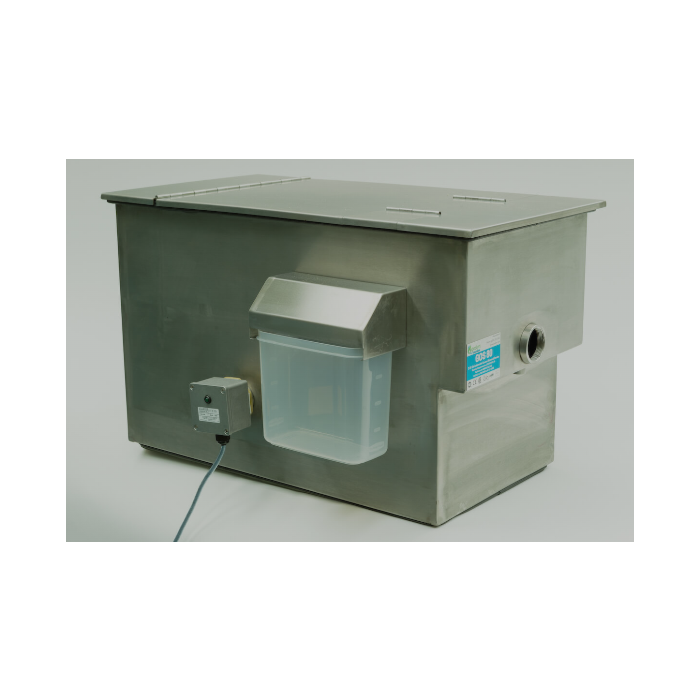
The Importance of Regular Grease Trap Maintenance
In the bustling environment of a commercial kitchen, the maintenance of grease traps often takes a backseat, but its importance cannot be overstated. Grease traps play a crucial role in preventing fats, oils, and grease (FOG) from entering and clogging the sewage system. An efficient grease trap maintenance schedule not only ensures compliance with environmental regulations but also guarantees the smooth functioning of kitchen operations.
Passive Grease Traps & Automatic GRU's (Grease Removal Units)
Passive grease traps and automatic grease removal units (GRU's) are two distinct types of systems designed to manage fats, oils, and grease (FOG) in commercial kitchens.
Passive grease traps, the more traditional form, rely on gravity to separate FOG from wastewater. As the wastewater cools, FOG rises to the top due to its lower density and is trapped, while the cleaner water exits the system. These traps require manual skimming and removal of the accumulated FOG, alongside regular cleaning of solid waste filters.
In contrast, automatic grease traps, or GRU's, are more advanced, equipped with mechanical and electrical components. They automatically separate and remove FOG from the system, storing it in a separate container. This not only streamlines the cleaning process but also reduces the frequency of manual intervention. However, they still require regular checks and maintenance, such as emptying the FOG container and ensuring the mechanical parts are functioning correctly.
Both systems, while differing in their operation and maintenance requirements, are essential for effective FOG management, but the choice between them often depends on the specific needs and capabilities of the kitchen in question.
Bio-dosing systems, such as GreasePak, can be used in conjunction with passive/manual grease traps to break down FOG within the trap. Cleaning will still be required, however the amount of FOG in the trap should be less and therefore less frequent cleaning may be required. Even when bio-dosing is in use, levels of FOG should still be monitored daily. Read more about Grease Trap Dosing Systems and how they work.
Why Follow the 25% Rule?
The '25% Rule' is a guideline stating that once 25% of a grease trap's capacity is filled with FOG and solid waste, it should be cleaned. This rule is vital because:
- Efficiency: A grease trap filled beyond 25% of its capacity cannot effectively separate FOG from wastewater.
- Compliance: Many local regulations mandate adherence to this rule to prevent sewer blockages and environmental hazards.
- Longevity: Regular maintenance extends the life of the grease trap and prevents costly repairs or replacements.

In-House Cleaning Tasks (Daily)
For Passive Grease Traps
- FOG Removal: Skim and remove the top layer of FOG daily. Staff must use Personal Protective Equipment (PPE) during this process. The collected FOG must be stored appropriately and disposed of by a licensed contractor.
- Inspection: Check daily for any obvious faults or issues with the actual grease trap and ensure couplings are still achieving a tight seal.
- Solid Waste Management: Remove and empty the solids container or filter.
- External Cleanliness: Ensure the external parts of the trap are clean.
- Scrape Plates/Pans: This helps reduce the amount of FOG that enters the trap.
- Log Maintenance: Update the cleaning and maintenance log after every cleaning or maintenance.*
For Automatic Grease Traps
- FOG Container Management: Remove and empty the FOG container. Ensure it's appropriately stored in sealed containers and disposal is handled by a licensed contractor.
- Inspection: Check daily for any obvious faults or issues with the actual grease trap and ensure couplings are still achieving a tight seal.
- Solid Waste Management: Remove and empty the solids container or filter..
- External Cleanliness: Ensure the external parts of the trap are clean.
- Scrape Plates/Pans: This helps reduce the amount of FOG that enters the trap.
- Log Maintenance: Update the cleaning and maintenance log after every cleaning or maintenance.*

*Read more about the importance of filling out cleaning and maintenance logs and What Information Should Be Recorded in Grease Trap Management Records.
Specialist Cleaning Tasks (Quarterly)
These tasks should be completed by a third-party company and are crucial for both passive and automatic grease traps:
- Deep Clean: A thorough cleaning of the entire system.
- Electrical and Mechanical Service: Regular servicing ensures that automatic grease traps function optimally.
Adhering to a strict cleaning schedule for grease traps is not just about maintaining kitchen hygiene but also about protecting the environment and ensuring compliance with local regulations. By following the 25% rule and the outlined daily and quarterly maintenance tasks, as well as consulting with your local water authority, restaurants and other food establishments can ensure their operations run smoothly and responsibly.

Leave a Comment
Your email address will not be published. Required fields are marked *